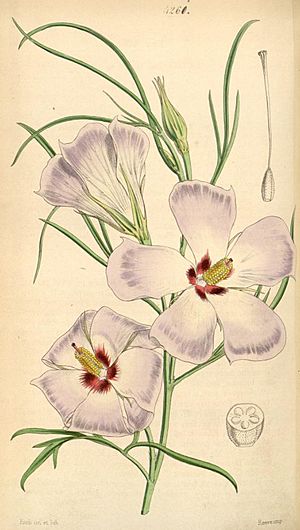Alyogyne hakeifolia facts for kids
Quick facts for kids Alyogyne hakeifolia |
|
|---|---|
 |
|
| Scientific classification | |
| Kingdom: | |
| (unranked): | |
| (unranked): | |
| (unranked): | |
| Order: | |
| Family: | |
| Subfamily: |
Malvoideae
|
| Genus: |
Alyogyne
|
| Species: |
A. hakeifolia
|
| Binomial name | |
| Alyogyne hakeifolia (Giord.) Alef.
|
|
| Synonyms | |
|
Alyogyne lilacina (Lindl.) Lewton |
|
Alyogyne hakeifolia is a type of flowering plant. It belongs to the Malvaceae family, which also includes cotton and hibiscus. This plant is only found in the southern parts of Australia.
For many years, people thought this plant was a type of Hibiscus. It looks very similar to a hibiscus plant. People have been growing Alyogyne hakeifolia in England since the mid-1800s.
Contents
What it Looks Like
Alyogyne hakeifolia grows as an upright shrub. It can reach up to three meters (about 10 feet) tall. The plant has many fine leaves covering its branches. It grows very quickly, especially when it has good growing conditions.
The flowers usually start to bloom between May and August in Australia. They continue to flower until February. The flowers can be blue, purple, or different shades of creamy yellow. When the flowers get older, they become darker and feel like paper.
After the first or second year, the plant produces many flowers. These flowers are shaped like deep cups. They have five large petals that open up. In the center of the flower, there is a deep red spot.
You can tell Alyogyne hakeifolia apart from a Hibiscus plant. Alyogyne hakeifolia has a single, undivided stigma. The stigma is the part of the flower that receives pollen.
How it Got its Name
The first time this plant was collected was in 1802. Robert Brown, a botanist, found it in South Australia. He called it Hibiscus Filifolius at that time. Ferdinand Bauer drew a sketch of the plant, which later became a watercolor painting.
Over the years, the plant was given many different names. Some of these names included Hibiscus Hakeifolius and Fugosia Hakeifolia.
The name we use today, Alyogyne hakeifolia, was given in 1863. It was named by Friedrich Alefeld in a magazine called Österreichische botanische Zeitschrift. This happened after Ferdinando Giordano described it in 1833. In 1846, William Jackson Hooker also called it a Hibiscus.
Later, in 1966, Paul Fryxell wrote about this plant. He said it was one of only two species in a special Australian group of plants. In 1968, it was officially moved into the Alyogyne group.
Where it Grows
Alyogyne hakeifolia is found in many places in southwest Western Australia. It also grows further east in a dry area called the Eremaean botanical province.
This plant likes to grow on rolling plains with red sand. It can also be found on rocky soils. Sometimes, it grows on limestone in these areas.
Growing Alyogyne hakeifolia
The leaves of Alyogyne hakeifolia can look different from one plant to another. Plant growers have used these natural differences to create new types for sale. Some types of Alyogyne plants have wider or lobed leaves. These might have been mixed with Alyogyne huegelii to create new varieties. You might still see older names like Hibiscus hakeifolia in some plant guides.
It is easy to grow new plants from cuttings. These plants need soil that drains water well. They should also be protected from frost. It's also important to be careful with phosphorus in the soil, as some plants from this region are sensitive to it.
Alyogyne hakeifolia was grown in greenhouses in England during the 1800s. Today, people grow it in places with mild climates, like parts of the United States and Europe.
The plant was shown in a famous publication called Curtis's Botanical Magazine. It says the plant was brought to England in 1846. It came from 'Swan River seeds' by Messrs. Lucombe and Pince. The same year, Hooker wrote that the plant flowered in its first summer.
Images for kids
See also
 In Spanish: Alyogyne hakeifolia para niños
In Spanish: Alyogyne hakeifolia para niños



